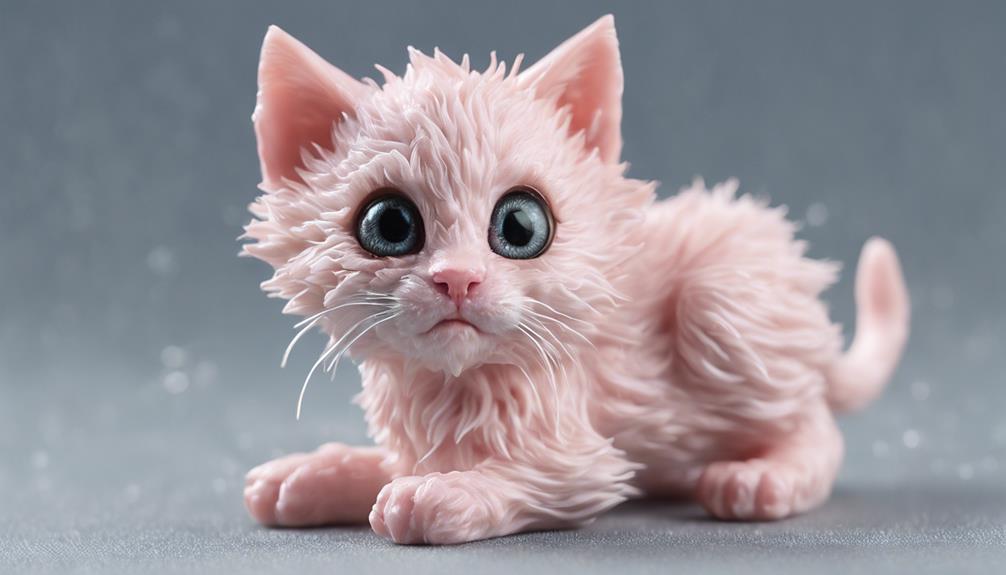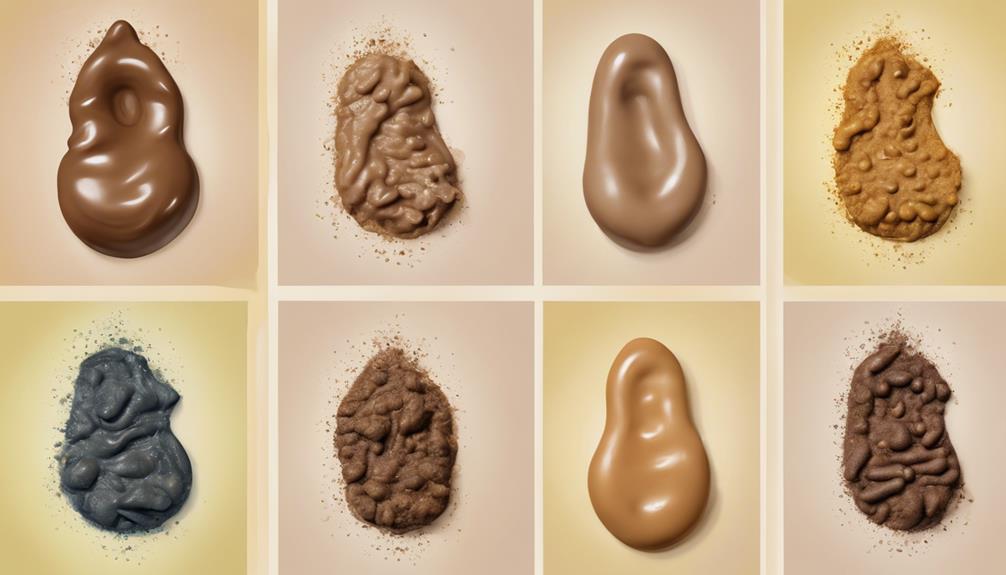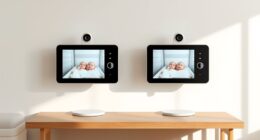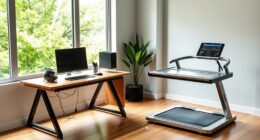When your newborn starts hiccuping after breastfeeding, it can feel like a small glitch in their delicate system. You may be wondering how to provide comfort in these moments.
There are indeed 10 effective ways to help ease your little one's hiccups and bring them peace. From simple techniques like burping and adjusting feeding positions to exploring soothing options like gripe water and gentle massages, each method offers a unique approach to soothing those post-feeding hiccups.
Stay tuned to discover the array of strategies available to calm your hiccup-prone newborn.
Key Takeaways
- Swaddle snugly, offer a pacifier, gently burp, and try different feeding positions to soothe newborn hiccups effectively.
- Use gripe water cautiously for colic relief, consider massage techniques, and adjust breastfeeding for hiccups after feeding.
- Seek professional guidance for persistent hiccups, ensuring the baby's well-being and addressing underlying issues promptly.
- Experiment with soothing methods, maintain a calm environment, and prioritize the baby's comfort to alleviate post-breastfeeding hiccups.
Swaddle Your Baby
Swaddle your newborn snugly after feeding to create a cozy, secure environment that can help ease their hiccups and provide comfort.
Swaddling isn't just about wrapping your baby in a blanket; it's a way to mimic the warmth and safety of the womb. By swaddling your little one, you prevent sudden movements that might trigger those pesky hiccups, giving them a sense of security that aids in relaxation.
This snug wrapping can also help regulate their body temperature, ensuring they stay comfortably warm. The gentle pressure from swaddling can be incredibly soothing, helping your baby drift off to sleep peacefully.
Remember, though, it's important to swaddle correctly to avoid any risks. Make sure the swaddle is snug but not too tight, allowing proper hip movement and ensuring your baby can breathe comfortably.
Embrace the art of swaddling to provide your newborn with the security and calmness they need after breastfeeding.
Offer a Pacifier
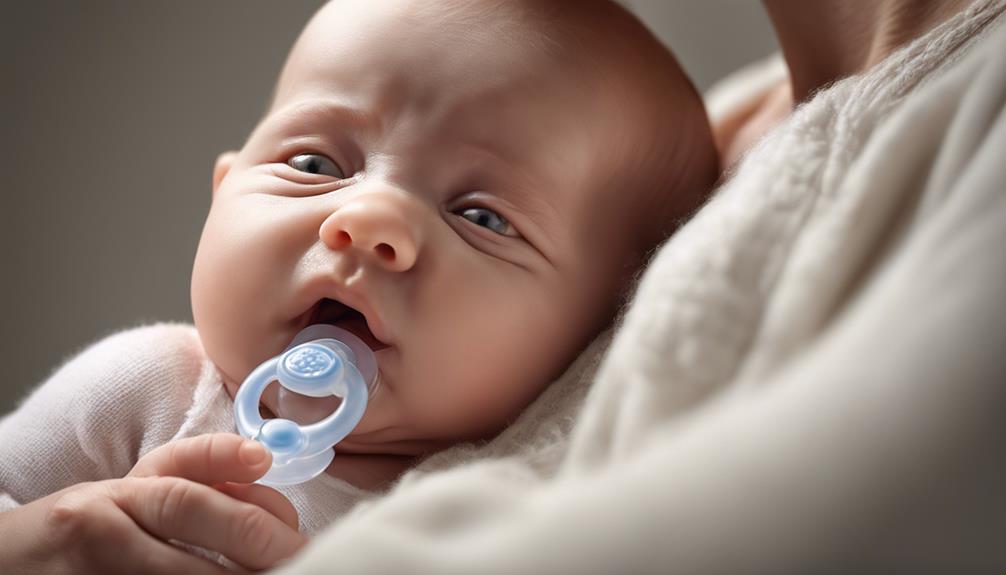
If your newborn has hiccups after feeding, offering a pacifier could be a helpful way to soothe them. The sucking action can relax their diaphragm and regulate breathing, potentially easing hiccups.
Consider timing it after breastfeeding to aid in calming your baby's discomfort.
Pacifier as Soothing Tool
After breastfeeding, consider offering a pacifier to help ease your newborn's hiccups and promote relaxation in their diaphragm. Pacifiers are a soothing tool that can provide comfort to your baby by allowing them to suck and swallow, which may help stop hiccups.
The sucking action on the pacifier can aid in calming your baby's breathing and diaphragm muscle, potentially alleviating the hiccups. This gentle method is safe to use and can effectively regulate your newborn's breathing pattern, addressing the hiccups without causing harm.
Timing for Pacifier
Consider offering a pacifier immediately after feeding to help relax your baby's diaphragm and potentially alleviate hiccups. The sucking action on the pacifier can assist in regulating your newborn's breathing pattern post-breastfeeding. Using a pacifier at the right timing can provide comfort and reduce the duration of hiccups in newborns. Pacifiers are safe for newborns and offer a gentle and non-invasive way to soothe them after breastfeeding sessions.
| Timing for Pacifier | |
|---|---|
| Benefits | Considerations |
| Helps relax diaphragm | Regulates breathing |
| Alleviates hiccups | Offers comfort |
Burp Your Newborn Gently
To help soothe your newborn's hiccups after breastfeeding, gently pat or rub their back to release trapped air. Burping your baby is an important step in preventing discomfort and reducing the frequency of hiccups that can occur after feeding. By burping your newborn in an upright position, you can effectively aid in expelling trapped air, thereby alleviating hiccups more efficiently.
Establishing a consistent burping routine after each breastfeeding session can greatly help in preventing hiccups in newborns. Remember, creating a calm and soothing environment while burping your baby can further aid in soothing hiccups post-feeding. By incorporating gentle and supportive burping practices into your baby's feeding routine, you can help secure their comfort and reduce instances of hiccups that may follow. Be patient and attentive during the burping process, as this simple act can make a significant difference in your newborn's well-being.
Change Feeding Positions
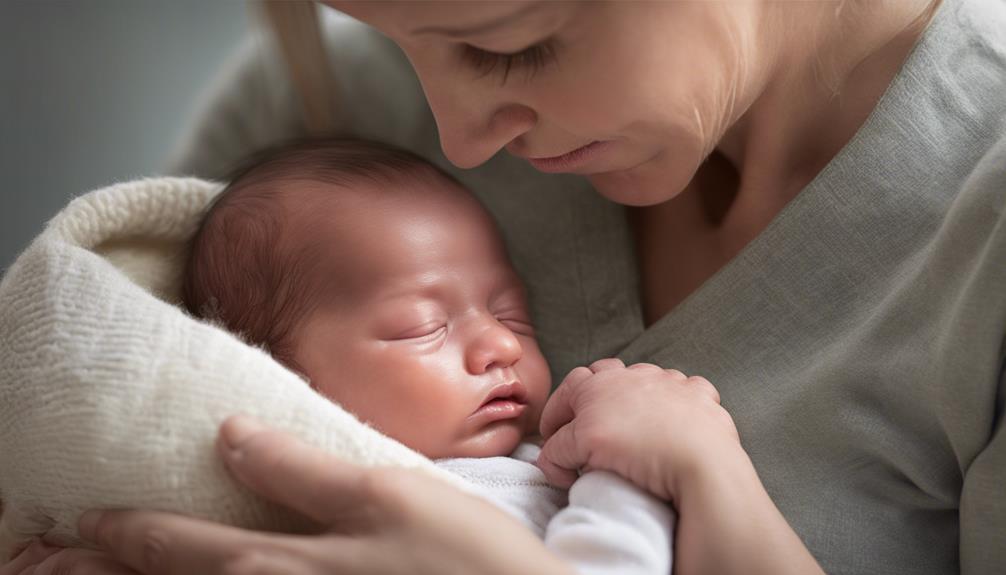
When your newborn gets the hiccups after feeding, changing positions can be a game-changer. Trying out different breastfeeding positions like the football hold or side-lying might help reduce those pesky hiccups.
It's all about finding what works best for you and your little one to bring some relief.
Positioning for Relief
Experiment with various feeding positions to find the best posture that helps relieve your newborn's hiccups effectively. Here are some tips to help you position your baby for relief:
- Hold Your Baby Upright: Try holding your baby in a more upright position while feeding to reduce pressure on the diaphragm and minimize hiccups.
- Lay Your Baby on Their Side: Laying your baby on their side during or after feeding can also help alleviate hiccups by adjusting their posture and aiding in digestion.
- Use a Nursing Pillow: Support your baby with a nursing pillow or cushion to create a comfortable and effective breastfeeding position, reducing the likelihood of hiccups.
Gentle Burping Techniques
Consider gently patting or rubbing your baby's back while holding them upright to facilitate burping and alleviate hiccups after feeding sessions. Changing breastfeeding positions can help guarantee air swallowing, reducing the chances of hiccups.
Try adjusting the feeding angle to a more upright position to aid in burping and release trapped air. Using a nursing pillow can assist in achieving a proper latch, minimizing air intake, and decreasing post-feeding hiccups.
Remember to take short breaks during feeding to burp your baby, allowing excess air to escape. By incorporating these gentle burping techniques and being mindful of your breastfeeding positions, you can provide assurance for your newborn's hiccups and ensure a more comfortable feeding experience.
Use Gentle Rocking Motions

To soothe your newborn with hiccups, gently rock them in your arms or in a rocking chair to provide calming movement that may relax their diaphragm and alleviate discomfort. Here are some tips to help you effectively use gentle rocking motions:
- Find a Comfortable Position: Sit in a cozy chair or find a spot where you can comfortably hold your baby while rocking them gently. Ensuring your own comfort will allow you to focus on soothing your little one.
- Maintain a Gentle Rhythm: Rock your baby in a smooth and consistent rhythm to create a comforting motion. This steady movement can help distract your baby from the hiccups and promote relaxation.
- Use Soft Singing or Shushing Sounds: Incorporate soft singing or shushing sounds while rocking your baby. The combination of gentle rocking and soothing sounds can create a calming environment that eases your baby's discomfort.
Maintain a Calm Environment
Maintaining a vital environment post-rocking is essential for helping your newborn relax and alleviate hiccups. After breastfeeding, creating a peaceful atmosphere can work wonders in settling your little one.
Dim the lights and reduce noise levels to promote relaxation, aiding in stopping those pesky hiccups. Gentle movements like swaying or holding your baby upright can also assist in soothing their diaphragm and easing discomfort.
It's essential to avoid sudden jerky motions or loud sounds that might startle your baby and trigger more hiccups. By maintaining a serene setting, you provide a comforting space for your newborn to unwind and naturally alleviate hiccups.
Try Gripe Water
If your newborn is experiencing hiccups after feedings, consider trying gripe water as a natural remedy.
With ingredients like ginger and fennel, gripe water can help calm your baby's digestive system.
Remember to consult your healthcare provider first to make sure gripe water is safe for your little one.
Gripe Water Benefits
Consider trying gripe water, an over-the-counter remedy containing herbs known for potentially soothing digestive discomfort in newborns, to help alleviate hiccups in your baby. Here are some benefits of gripe water:
- Natural Ingredients: Gripe water often contains natural ingredients like ginger and fennel, which have been traditionally used to aid digestion and relieve discomfort in infants.
- Colic Relief: This remedy is commonly used to alleviate colic, gas, and hiccups in babies, making it a versatile option for soothing your little one.
- Safe Usage: While gripe water is generally safe when used as directed, consulting your healthcare provider before administering it to your baby is recommended for personalized advice and guidance.
Gripe Water Usage
Ease your newborn's hiccups by trying gripe water, an over-the-counter remedy containing herbs known to soothe digestive discomfort in infants.
Gripe water is commonly used to alleviate colic, gas, and hiccups in babies, particularly those experiencing hiccups after breastfeeding. While its specific efficacy for hiccups may vary, many parents find it helpful.
It's generally safe for babies over one month old, following the recommended dosage on the product label. Before giving gripe water to your baby, consulting a healthcare provider is recommended to make sure it's suitable for your baby's situation.
Offer a Soothing Massage
When soothing a newborn with hiccups, start by gently massaging their back or belly in a circular motion to help relieve discomfort. This simple technique can work wonders in calming your little one and easing their hiccups.
Here are some tips to make the massage more effective:
- Use a warm washcloth or your fingertips: Applying gentle pressure with a warm washcloth or using your fingertips can enhance the soothing effect of the massage, promoting relaxation for your baby.
- Focus on relaxing the diaphragm: Massaging helps relax the diaphragm, which can reduce spasms causing hiccups in newborns. By targeting this area, you can address the root cause of the hiccups and provide relief to your baby.
- Make certain cleanliness: Before giving your baby a massage, make sure your hands are clean and your nails are trimmed. This precaution is essential to maintain hygiene and prevent any irritation to your baby's delicate skin.
Adjust Your Breastfeeding Technique
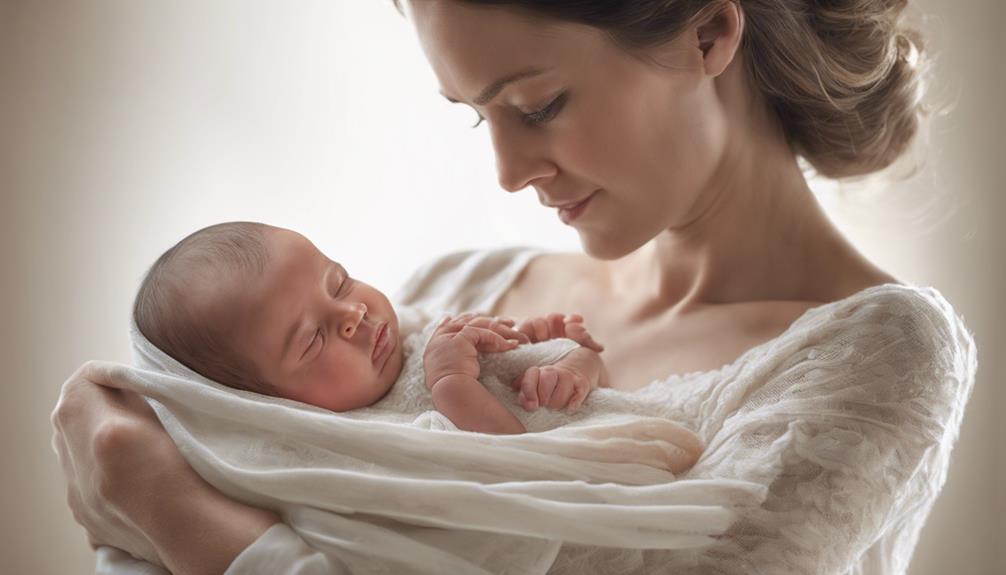
To improve your newborn's comfort during breastfeeding and reduce hiccups, guarantee a proper latch and positioning technique. Ensuring that your baby latches correctly onto your breast can help minimize the intake of air, which may be a common cause of hiccups. Additionally, finding a comfortable position for both you and your baby during feeding can make a significant difference in reducing hiccups. Here are some practical tips to consider:
| Breastfeeding Technique | Proper Latch | Positioning |
|---|---|---|
| Check latch quality frequently | Ensure a deep latch | Experiment with different positions |
| Watch for signs of discomfort | Avoid nipple feeding | Support your baby's head and neck |
| Take short breaks to burp | Listen for swallowing sounds | Use pillows for support |
Consult With a Healthcare Provider

Seek guidance from a healthcare provider if your newborn experiences persistent hiccups after breastfeeding to guarantee their well-being and address any potential underlying issues. Healthcare providers can offer personalized guidance on soothing techniques tailored to your newborn's specific needs. They can help determine if the hiccups are a standard physiological response or if further evaluation is necessary.
Seeking professional advice guarantees the safety and well-being of your newborn when dealing with hiccups after breastfeeding. Healthcare providers can provide reassurance and support to help you navigate and alleviate your newborn's hiccups post breastfeeding. Remember, consulting with a healthcare provider is a proactive step towards understanding and managing your newborn's hiccups effectively.
Your healthcare provider is there to support you and your baby, offering expert advice and guidance tailored to your unique situation. Don't hesitate to reach out for the personalized care your newborn deserves.
Frequently Asked Questions
How Do I Stop My Baby From Hiccuping After Breastfeeding?
To help stop your baby from hiccuping after breastfeeding, burp them to release trapped air, keep them upright for 20-30 minutes post-feeding, avoid overfeeding, gently pat or rub their back, and offer a pacifier for comfort.
How Can I Soothe My Newborn's Hiccups?
When your newborn gets hiccups after breastfeeding, try burping, giving a pacifier, keeping them upright, avoiding overfeeding, or patting their back gently. These simple steps can help soothe your little one and ease those pesky hiccups.
Is It OK to Lay Baby Down With Hiccups?
It's safe to lay your baby down with hiccups after breastfeeding if they're comfy. Hiccups are common and usually harmless. Trust your gut and watch for signs of distress. If baby's chill, no need to keep them upright.
Should I Stop Feeding Newborn With Hiccups?
You don't need to stop feeding your newborn with hiccups. It's safe to continue. Pausing to burp can help. Hiccups won't harm feeding. Keep breastfeeding for your baby's nourishment and comfort; hiccups are usually harmless during feeding.
Conclusion
To sum up, remember to be patient and try different soothing techniques to alleviate your newborn's hiccups after breastfeeding. Consulting with a healthcare provider can provide valuable guidance.
Remember, staying calm and comforting your little one is key. Soothe your sweet bundle with care and cuddles.




